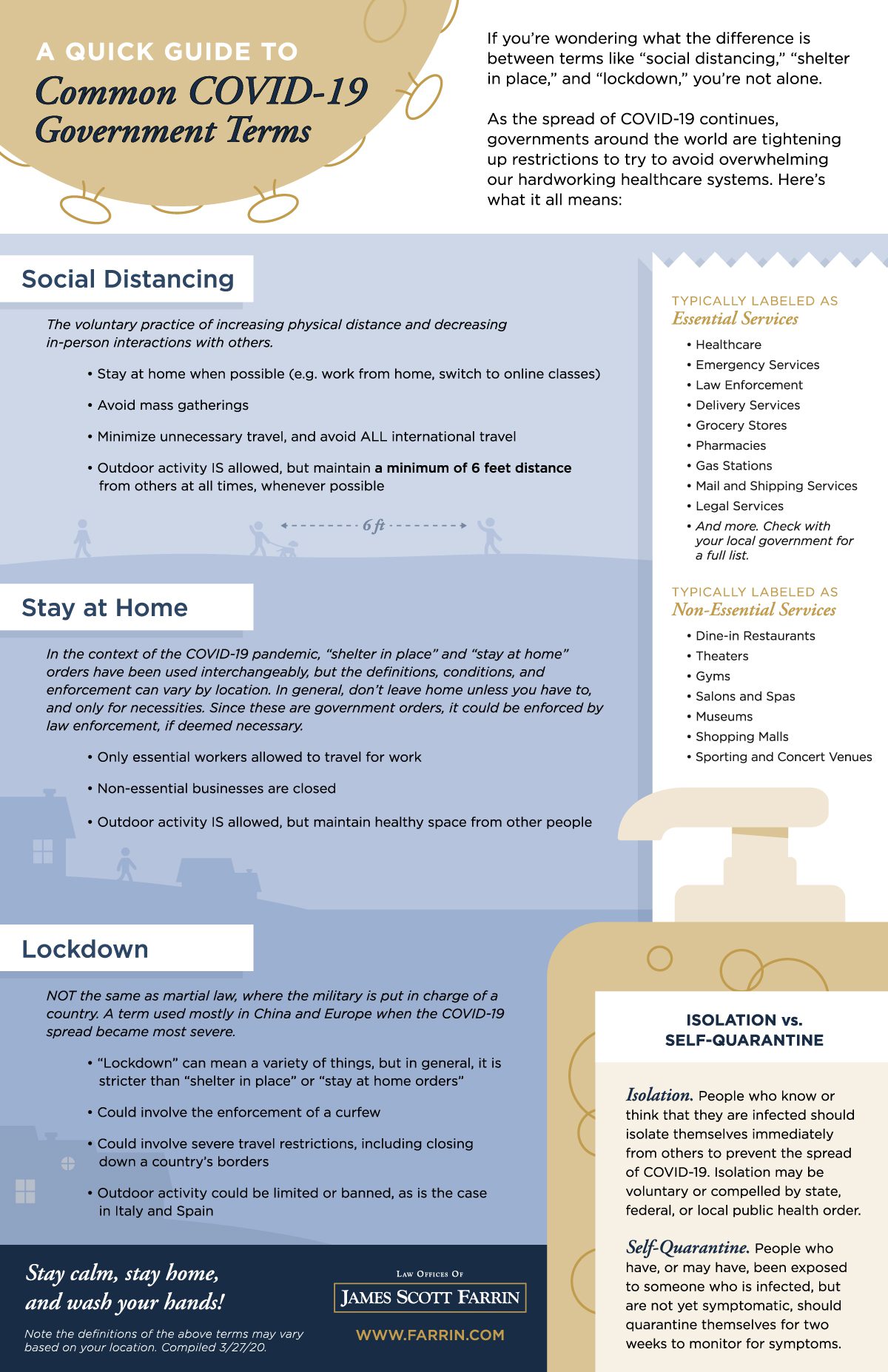COVID-19 Government Terms
Understanding the Difference Between Social Distancing, Shelter in Place, Stay at Home, and Lockdowns
To help curb the coronavirus (COVID-19) pandemic, cities, counties, states, and even entire countries have instructed the general population to “socially distance” — a term that no doubt has become a permanent part of the world’s vocabulary within a matter of weeks.
As more and more governments follow suit, there’s undoubtedly a lot of misinformation that is going around with what officials are doing to help the community stay safe and healthy. Therefore, it’s important to understand what these all mean, so we’ve compiled some information to make it easier for you to understand.
See our infographic guide to common COVID-19 terms here and read below for even more information.
A Quick Guide to Common COVID-19 Government Responses
If you’re wondering what the difference is between social distancing vs. shelter in place/stay at home vs. lockdown, you’re not alone. As the spread of COVID-19 continues, governments around the world are tightening up restrictions to try to avoid overwhelming our hardworking healthcare systems. Here’s what it all means:
Social Distancing
This is the voluntary practice of increasing physical distance and decreasing in-person interactions with others. In general it means to:
- Stay at home when possible (e.g. work from home, switch to online classes)
- Avoid mass gatherings
- “Mass gathering”: If the number of people it brings together is so large that it has the potential to strain the planning and response resources of the health system in the community where it takes place, then it counts as a mass gathering, according to the World Health Organization.
- Minimize unnecessary travel, and avoid ALL international travel, the CDC advises
- Outdoor activity IS allowed, but maintain a minimum of 6 feet distance from others at all times, whenever possible
Shelter in Place or Stay at Home Orders
In the context of the COVID-19 pandemic, these two terms have been used interchangeably, but the definitions, conditions, and enforcement can vary by location. In general, don’t leave home unless you have to, and only for necessities. Since it is a government order, it could be enforced by law enforcement, if deemed necessary.
- Only essential workers are allowed to travel for work (see below for a list of business typically labeled as essential and non-essential)
- Non-essential businesses are closed
- Outdoor activity IS allowed, but maintain healthy space from other people
IMPORTANT NOTE: “Shelter in place” is typically used in in the context of hurricanes, floods, chemical plant explosions, active shooters, etc. Usually a shelter in place order only lasts a few hours, enough for the danger to pass. However, officials have used “shelter in place” to mean “stay at home” in the context of the COVID-19 pandemic. In order to avoid confusion, many officials are now using the term “stay at home,” or a variation thereof, but “shelter in place” is sometimes still being used interchangeably.
Lockdown
Note this is NOT the same as martial law, where the military is put in charge of a country. “Lockdown” is a term used mostly in China and Europe, where the COVID-19 spread is most severe. It can mean a variety of things, but in general, it is stricter than shelter in place or stay at home orders.
- Could involve the enforcement of a curfew
- Could involve severe travel restrictions, including closing down a country’s borders
- Outdoor activity could be limited or banned, as was the case in Italy and Spain
The Difference Between Isolation and Self-Quarantine
ISOLATION: People who know, or reasonably believe, that they are infected should isolate themselves immediately from others to prevent the spread of COVID-19. Isolation may be voluntary or compelled by state, federal, or local public health order.
SELF-QUARANTINE: People who have, or may have been, exposed to someone who is infected, but are not yet symptomatic, should quarantine themselves for two weeks and closely monitor themselves for symptoms of COVID-19. If symptoms show within those two weeks, call a healthcare professional.
What is Considered an Essential vs. a Non-Essential Service?
Who is considered essential vs. non-essential personnel and services varies by location, and may be subject to change. We encourage you to check your local government order to get a full list.
The list below was taken from the stay at home orders from two of the largest counties in North Carolina by population — Mecklenburg County and Wake County.
THOSE TYPICALLY CLASSIFIED AS ESSENTIAL:
- Hospitals and healthcare providers
- Law enforcement
- Firefighters
- Emergency Medical Services (EMS)
- Mail, post, shipping, and delivery services
- Funeral services
- Food, beverage, and agriculture (e.g. manufacturing, production, processing, cultivation)
- Groceries and pharmacies
- Media
- Gas stations and businesses necessary for transportation (e.g. auto repair shop)
- Financial institutions
- Hardware and supply stores
- Critical trades (e.g. tradesmen and women like plumbers, electricians, HVAC, exterminators, cleaning staff, security staff, etc.)
- Transportation services (only for essential travel)
- Hotels and motels
- Professional services including legal, accounting, insurance, and some real estate
THOSE TYPICALLY CLASSIFIED AS NON-ESSENTIAL:
- Dine-in restaurants and bars
- Theaters
- Gyms and recreation centers
- Salons and spas
- Museums
- Sporting and concert venues
- Casinos and racetracks
- Shopping malls and outlets
- Bowling alleys
- Skating rinks
At the Law Offices of James Scott Farrin, we’re passionate about helping injured people. The definitions and terms above may vary by location, and may be subject to change. Information compiled 3/26/20.



